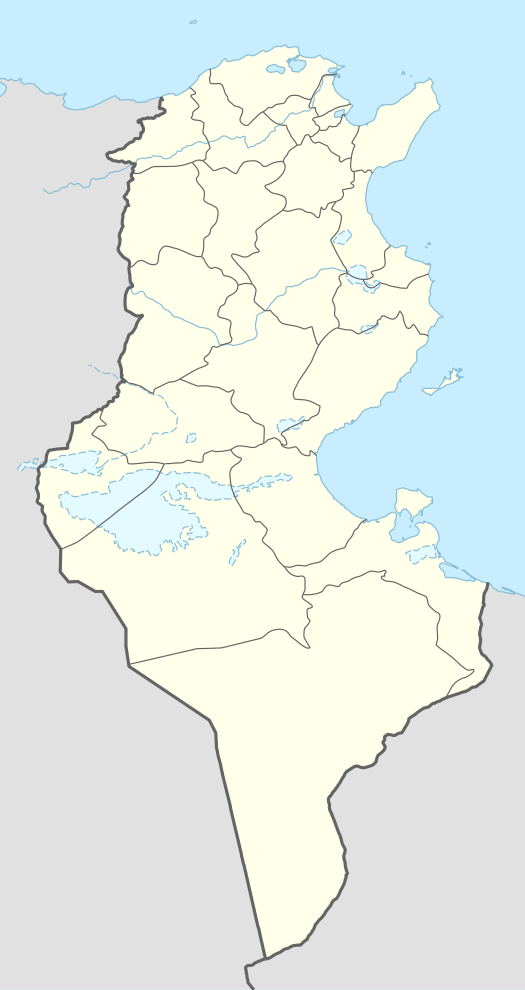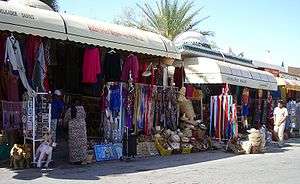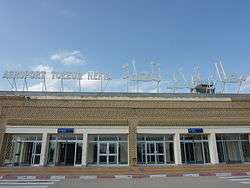Tozeur
Tozeur (Arabic: توزر ![]()
Tozeur Tuzer / ⵜⵓⵣⴻⵔ / توزر | |
|---|---|
Habib Bourguiba Avenue, Tozeur | |
 Tozeur Location in Tunisia | |
| Coordinates: 33°55′N 8°8′E | |
| Country | |
| Governorate | Tozeur |
| Delegation | Tozeur |
| Government | |
| • Mayor | Ali Jeddi Hafsi |
| Population (2014) | |
| • City | 37,370 |
| • Metro | 46,422 |
| • Religions | Islam |
| Time zone | UTC+1 (CET) |
| Website | http://www.commune-tozeur.gov.tn/ |

History

During the Roman Empire and the Byzantine Empire and in the Vandal Kingdom, Tozeur was the site of Tusuros, in the Roman province of Byzacena (originally part of Africa Proconsularis).
Bishopric
At this time it was the seat of a suffragan bishopric, called Tusuros.[1]
Located in the Sahel hinterland of the Byzacena coastline, close to the towns of Aquae and Nefta and south of Capsa and Ad Turres,[2] Roman Tursuros became an important center of Donatism.[3]
The Bishopric ceased to function following the seventh century the arrival of Islam The remains of an ancient church are visible in the foundations of an old mosque of Tozeur.
Four bishops (two canonical, two schismatic Donatist heretics) are historically documented
- Bennatus, partook in the Council of Cabarsussi, held in 393 by Maximianists, a sect of dissident Donatists, and signed their acts.
- Asellicus, 4th century bishop, known from correspondence with Augustine of Hippo and Donatian of Reims and from tracts against one Aptus who was accused of Judaising.[4][5] He attended the Council of Carthage (411) where the prevailing Catholics condemned Donatism as heresy.
- Florentinus participated in the Council of Carthage called in 484 by the Arian king Huneric of the Vandal Kingdom, whereafter he was exiled like most Catholic bishops, unlike Aptus, Asellicus' Donatist rival.[6]
Titular see
It was nominally restored in 1933 as Latin titular bishopric of Tusuros (Latin) / Tusuro (Curiate Italian) / Tusuritan(us) (Latin adjective) of the Roman Catholic Church.[7]
It has had the following incumbents, so far of the fitting Episcopal (lowest) rank:
- Joseph Leo Cardijn (born Belgium) (1925 February 15, 1965 February 22, 1965), Founder of the international Young Christian Workers (CAJ) then without prelature; later created Cardinal-Deacon of S. Michele Arcangelo (1965.02.25 – death 1967.07.25)
- Giovanni Benelli (June 11, 1966 - June 3, 1977) as papal diplomat : Apostolic Pro-Nuncio to Senegal (1966.06.11 – 1967.06.29), Apostolic Delegate to Western Africa (1966.06.11 – 1967.06.29) and Roman Curia official : Substitute for General Affairs of Secretariat of State (1967.06.29 – 1977.06.03); later Metropolitan Archbishop of Firenze (Italy) (1977.06.03 – 1982.10.26), created Cardinal-Priest of S. Prisca (1977.06.27 – death 1982.10.26)
- Thomas Cajetan Kelly (June 12, 1977 December 28, 1981) as Auxiliary bishop of Archdiocese of Washington (D.C.. United States) (1977.06.12 – 1981.12.28); later Metropolitan Archbishop of Louisville (USA) (1981.12.28 – retired 2007.06.12), died 2011
- Paul Lanneau (1982.02.14 – death 2017.01.26), first as Auxiliary Bishop of Archdiocese of Mechelen-Brussels(Belgium) (Belgium) (1982.02.14 – 2002.03.20), then as emeritus.
- Bishop-elect Amilton Manoel da Silva, Passionists (C.P.) (2017.06.07 – ...) as Auxiliary Bishop of Archdiocese of Curitiba (Brazil) (2017.06.07 – ...).
Geography
Climate
.jpg)
Tozeur has a hot desert climate (Köppen climate classification BWh) typical of the northern edge of the Sahara Desert. The annual average rainfall amount reaches 80.8 mm, and the annual mean temperature (day and night) reaches 22.2 °C, both making the city hot and dry year-round. The weather is usually settled and sunny throughout the year. Summers are extremely hot with daily highs often exceeding 45 °C in the shade, and the sirocco may push temperatures above 50 °C. During winters, it can sometimes freeze at night and just before the sunrise, as the temperature may drop below 0 °C.
| Climate data for Tozeur (1981–2010, extremes 1950–2017) | |||||||||||||
|---|---|---|---|---|---|---|---|---|---|---|---|---|---|
| Month | Jan | Feb | Mar | Apr | May | Jun | Jul | Aug | Sep | Oct | Nov | Dec | Year |
| Record high °C (°F) | 25.0 (77.0) |
31.7 (89.1) |
39.8 (103.6) |
40.2 (104.4) |
46.6 (115.9) |
48.0 (118.4) |
48.8 (119.8) |
48.0 (118.4) |
45.2 (113.4) |
40.9 (105.6) |
33.6 (92.5) |
27.8 (82.0) |
48.8 (119.8) |
| Average high °C (°F) | 16.5 (61.7) |
19.2 (66.6) |
23.0 (73.4) |
26.9 (80.4) |
31.8 (89.2) |
36.7 (98.1) |
39.5 (103.1) |
39.3 (102.7) |
34.6 (94.3) |
29.2 (84.6) |
22.2 (72.0) |
17.4 (63.3) |
28.0 (82.5) |
| Daily mean °C (°F) | 11.4 (52.5) |
13.6 (56.5) |
17.1 (62.8) |
20.7 (69.3) |
25.3 (77.5) |
29.7 (85.5) |
32.5 (90.5) |
32.5 (90.5) |
28.6 (83.5) |
23.6 (74.5) |
17.0 (62.6) |
12.4 (54.3) |
22.0 (71.7) |
| Average low °C (°F) | 6.6 (43.9) |
8.2 (46.8) |
11.3 (52.3) |
14.6 (58.3) |
19.0 (66.2) |
23.2 (73.8) |
25.9 (78.6) |
26.3 (79.3) |
23.0 (73.4) |
18.4 (65.1) |
12.1 (53.8) |
7.7 (45.9) |
16.4 (61.5) |
| Record low °C (°F) | −2.6 (27.3) |
−1.6 (29.1) |
0.8 (33.4) |
4.4 (39.9) |
2.0 (35.6) |
14.4 (57.9) |
17.6 (63.7) |
17.8 (64.0) |
12.8 (55.0) |
5.8 (42.4) |
1.4 (34.5) |
0.0 (32.0) |
−2.6 (27.3) |
| Average precipitation mm (inches) | 17.0 (0.67) |
5.1 (0.20) |
8.7 (0.34) |
13.3 (0.52) |
6.8 (0.27) |
1.8 (0.07) |
0.6 (0.02) |
2.1 (0.08) |
9.7 (0.38) |
8.9 (0.35) |
11.3 (0.44) |
10.7 (0.42) |
96 (3.76) |
| Average precipitation days (≥ 1.0 mm) | 1.7 | 1.6 | 1.8 | 1.5 | 1.2 | 0.5 | 0.1 | 0.4 | 1.1 | 1.5 | 1.8 | 1.6 | 14.8 |
| Average relative humidity (%) | 63 | 55 | 52 | 49 | 46 | 42 | 40 | 44 | 51 | 56 | 60 | 64 | 52 |
| Mean monthly sunshine hours | 201.5 | 198.8 | 235.6 | 243.0 | 282.1 | 279.0 | 331.7 | 310.0 | 264.0 | 238.7 | 201.0 | 201.5 | 2,986.9 |
| Source: Institut National de la Météorologie (precipitation days/humidity/sun 1961–1990)[8][9][10][note 1] | |||||||||||||
Modern town
With hundreds of thousands of palm trees, Tozeur is a large oasis. Dates are exported from Tozeur. In ancient times, before the advent of motorized vehicles, the oasis was important for the transportation through the Sahara, which took place in caravans. The name of the city in antiquity was Tusuros, it was an important Roman outpost. The medina (old city) of Tozeur, contains traditional architecture, fashion and workmanship.
Architecture
Tozeur, in common with the surrounding Jerid region, is noted for its yellow/brownish brickwork as well as its patterns in geometric designs which form the façades of most buildings in the old city and the new tourist zone.
 A local in traditional Berber clothing in the Medina
A local in traditional Berber clothing in the Medina The unique brickwork of the old streets in the medina quarter
The unique brickwork of the old streets in the medina quarter Another example of brick artistry in Tozeur's old city
Another example of brick artistry in Tozeur's old city
The old town of Ouled El Hwadef is an example of the local brickwork. Mandated by the local government, the narrow streets, walls and façades were decorated with bricks, which took more than 10 years to complete.
Sport
Tozeur has a football club who plays in the First Professional Federation of Football in Tunisia, the team is called LPS Tozeur. In 2010/2011 season the club almost made it to the First Professional Federation of Football.
Economy
Overview

Although still the largest part of the local economy, dates and farming are becoming less appealing to the young, who are more often employed in tourism. Tourism is heavily developed and promoted, and Tozeur is considered a center of "desert tourism" (Arabic: السياحة الصحراوية). The annual "International Festival of Oases" (Arabic: المهرجان الدولي للواحات بتوزر) takes place in the town in November and December each year.

The government initiated two large-scale projects:
- Tapping of deep aquifers by wells. This led to the depletion of most natural springs and abandonment of the traditional irrigation canals. Tozeur's oasis has been irrigated based on an open surface canal system designed in the 13th century by engineer Ibn Chabbat. This traditional irrigation system is currently being replaced by a system of concrete pipes. Water that was traditionally free to farmers is now being sold to offset the cost of these projects and pipes.
- The second part of these local projects is the initiation of new oases around town. These oases' productivity is very low and their future highly unstable.[12] This situation is slowly leading to the decay of the old oases (due to salinity, poor planning and lack of skilled workers) with productivity plummeting and the health and future of the oases questionable.

The region around Tozeur is seeing a large influx of unemployed workers and their families from the once rich phosphate region of Metlaoui, Gafsa and Oum Lerrayess in hope of work in the tourism sector. The phosphate mines are no longer productive and thousands of workers were laid off after the government sold them to European investors.
Overall the region, and Tozeur in particular, is going through a tough time. The region is embracing the unstable tourism economy and shying away from its traditional agricultural based economy. During the first Gulf War the sector suffered with a loss of large number of workers and an increase in unemployment. The same happened during September 11, 2001 attacks and the Iraq War.
Transport
The city is served by buses, taxis, railway, louage (shared or group taxi), and Tozeur–Nefta International Airport with national and international services from London, Paris, Rome and few other European countries (international flight services are mostly during the summer tourism season). Tozeur lies on the edge of the Sahara desert. Tourism activity is higher in the fall and winter months with Douz Festival among others in late December
People from Tozeur

- Abu-Qacem Echebbi (Arabic: أبو القاسم الشابي) (b. Tozeur, February, 1909; d. October 9, 1934), is a Tunisian poet. The current Tunisian anthem is based on one of his poems.
- Abu Yazid Makhlad ibn Kayrad (أبو يزيد مخلد بن كيراد), from the Berber Zenata tribe, nicknamed Sahib al-Himar (Arabic: صاحب الحمار) who led a mostly Berber revolution against the Fatimid ruler Al-Qa'im. The revolution, almost a success, was finally crushed by the caliph al-Mansur Billah.
- Ibn Chabbat (ابن شباط) AKA Mohamed Ben Ali Ben Mohamed Ben Ali, (October 16, 1221 – June 17, 1285 in Tozeur), is a writer, historian, engineer and a respected Tunisian social figure in the 13th century. Ibn Chabbat's main contribution and legacy is an open surface canals system for equitable water distribution in the oasis that is still in use nowadays.
- Ibn al-Kardabūs (13th century), jurist and historian of al-Andalus
- Brahim Dargouthi (born 1955) novelist."Nafta" a city located in the governorate of Tozeur, formerly, was known as the cradle of knowledge in North Africa. It is the "Koufa" of Africa.
The people of Tozeur have an unparalleled attachment to knowledge and science. This love for science is associated with high human values, including generosity, communicative enthusiasm, wisdom and humility.
Popular culture
Tozeur was used as a filming location for the Star Wars saga and Raiders of the Lost Ark (specifically Sidi Bouhlel canyon outside the town and the salt-flats of nearby Nefta). Lucasfilm also built an entire set a few kilometers north-west of Tozeur in the middle of the desert. This set acted as Mos Espa in Star Wars: Episode I – The Phantom Menace. The buildings are still there and can be visited. The English Patient (9 Oscars) with Ralph Fiennes and Kristin Scott Thomas was partially filmed outside Tozeur.
In May 1984 the Italian singers Alice and Franco Battiato represented Italy in the Eurovision Song Contest with the song "I treni di Tozeur" ("The Trains of Tozeur"), whose lyrics contain several references to Tozeur, the historic train Le Lézard rouge and Tunisian history in general. This song became a chart hit throughout Continental Europe and Scandinavia.
See also
- List of Catholic dioceses in Tunisia
References
- Tururos at catholic-hierarchy.org.
- Shaw, B.D. (2011). Sacred Violence: African Christians and Sectarian Hatred in the Age of Augustine. Cambridge University Press. p. 271. ISBN 9780521196055. Retrieved 2016-03-29.
- Brent D. Shaw, Sacred Violence: African Christians and Sectarian Hatred the Age of Augustine (Cambridge University Press, 2011) p 271.
- François Decret, Early Christianity in North Africa (Wipf and Stock Publishers, 2009) p150.
- Serge Lancel, Saint Augustine (Hymns Ancient and Modern Ltd, 2002) p356
- Serge Lancel, Saint Augustine (Hymns Ancient and Modern Ltd, 2002) p356
- Titular Episcopal See of Tusuros at GCatholic.org.
- "Les normales climatiques en Tunisie entre 1981 2010" (in French). Ministère du Transport. Archived from the original on 19 December 2019. Retrieved 3 February 2020.
- "Données normales climatiques 1961-1990" (in French). Ministère du Transport. Archived from the original on 21 December 2019. Retrieved 3 February 2020.
- "Les extrêmes climatiques en Tunisie" (in French). Ministère du Transport. Archived from the original on 21 December 2019. Retrieved 3 February 2020.
- "Réseau des stations météorologiques synoptiques de la Tunisie" (in French). Ministère du Transport. Retrieved 3 February 2020.
- Jacobs, Daniel; Morris, Peter (2001). The Rough Guide to Tunisia. Rough Guides. ISBN 978-1-85828-748-5.
Notes
- The Station ID for Tozeur is 66060111.[11]
Sources and external links
| Wikimedia Commons has media related to Tozeur. |
- GCatholic - (former &) titular bishopric

- Lexicon of the Orient article
- Arabic Atlas of Islamic History
- Star Wars locations in Tunisia
- Bibliography - ecclesiastical history
- Pius Bonifacius Gams, Series episcoporum Ecclesiae Catholicae, Leipzig 1931, p. 469
- Stefano Antonio Morcelli, Africa christiana, Volume I, Brescia 1816, pp. 341–342
- J. Mesnage, L'Afrique chrétienne, Paris 1912, pp. 163–164
